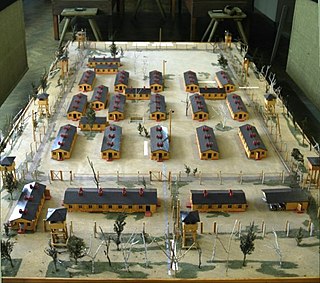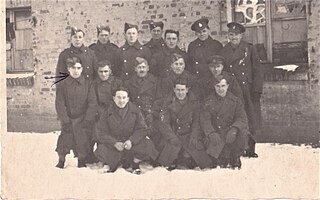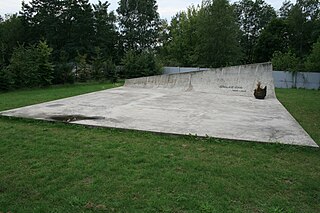Marlag und Milag Nord was a Second World War German prisoner-of-war camp complex for men of the British and Canadian Merchant Navy and Royal Navy. It was located around the village of Westertimke, about 30 km (19 mi) north-east of Bremen, though in some sources the camp's location is given as Tarmstedt, a larger village about 4 km (2.5 mi) to the west. There were also American merchant seamen detained here as well as some U.S. Navy personnel.

Stalag II-B was a German World War II prisoner-of-war camp situated 2.4 kilometres (1.5 mi) west of the town of Hammerstein, Pomerania on the north side of the railway line. It housed Polish, French, Belgian, Serbian, Dutch, Soviet, Italian and American prisoners of war.
Stalag III-C was a German Army World War II prisoner-of-war camp for Allied soldiers. It was located on a plain near the village of Alt Drewitz bei Küstrin then located in the Neumark of the province of Brandenburg, about 50 mi (80 km) east of Berlin.
Stalag XX-B was a German prisoner-of-war camp in World War II, operated in Wielbark. It housed Polish, British, French, Belgian, Serbian, Soviet, Italian, Australian, New Zealand and Canadian POWs.

Stalag XX-A was a German World War II prisoner-of-war camp located in Toruń in German-occupied Poland. It was not a single camp and contained as many as 20,000 men at its peak. The main camp was located in seven forts of the 19th-century Toruń Fortress, located in the southern part of the city.

Stalag Luft IV was a German World War II prisoner-of-war camp in Gross Tychow, Pomerania. It housed mostly American POWs, but also Britons, Canadians, Poles, Australians, New Zealanders, South Africans, Czechs, Frenchmen and a Norwegian.

In Germany, stalag was a term used for prisoner-of-war camps. Stalag is a contraction of "Stammlager", itself short for Kriegsgefangenen-Mannschaftsstammlager, a literal translation of which is "War-prisoner" "enlisted" "main camp". Therefore, technically "stalag" simply means "main camp".

Stalag III-A was a German World War II prisoner-of-war camp at Luckenwalde, Brandenburg, 52 kilometres (32 mi) south of Berlin. It housed Polish, Dutch, Belgian, French, Yugoslav, Russian, Italian, American, Romanian, British and other Allied POWs.

Stalag XI-B and Stalag XI-D / 357 were two German World War II prisoner-of-war camps (Stammlager) located just to the east of the town of Fallingbostel in Lower Saxony, in north-western Germany. The camps housed Polish, French, Belgian, Soviet, Italian, British, Yugoslav, American, Canadian, New Zealander and other Allied POWs.

Stalag VIII-A was a German World War II prisoner-of-war camp, located just to the south of the town of Görlitz in Lower Silesia, east of the River Neisse. The location of the camp lies in today's Polish town of Zgorzelec, which lies over the river from Görlitz.

Stalag VIII-B was a German Army prisoner-of-war camp during World War II, later renumbered Stalag-344, located near the village of Lamsdorf in Silesia. The camp initially occupied barracks built to house British and French prisoners in World War I. At this same location there had been a prisoner camp during the Franco-Prussian War of 1870-71.

Stalag VIII-C was a German World War II prisoner-of-war camp, near Sagan, Lower Silesia. It was adjacent to the famous Stalag Luft III, and was built at the beginning of World War II, occupying 48 ha. It housed Allied POWs of various nationalities, incl. Polish, French, Belgian, British, Canadian, Greek, Yugoslav, Soviet, Australian, New Zealand, South African, Italian, Senegalese, Algerian, Moroccan and Slovak.
Oflag X-B was a World War II German prisoner-of-war camp for officers (Offizierlager) located in Nienburg/Weser, Lower Saxony, in north-western Germany. Adjacent to it was the enlisted men's camp (Stammlager) Stalag X-C.
Stalag IX-C was a German prisoner-of-war camp for Allied soldiers in World War II. Although its headquarters were located near Bad Sulza, between Erfurt and Leipzig in Thuringia, its sub-camps – Arbeitskommando – were spread over a wide area, particularly those holding prisoners working in the potassium mines, south of Mühlhausen.

Camp Fünfeichen was a World War II German prisoner-of-war camp located in Fünfeichen, a former estate within the city limits of Neubrandenburg, Mecklenburg, northern Germany. Built as Stalag II-A Neubrandenburg in 1939, it was extended by the officer camp Oflag II-E in 1940. After the Soviet takeover in 1945 until 1949 it was used as special camp, NKVD-camp Nr. 9 of the Soviet secret service (NKVD). Today, the site of the camp is a memorial.

Stalag XVIII-A was a World War II German Army (Wehrmacht) prisoner-of-war camp located to the south of the town of Wolfsberg, in the southern Austrian state of Carinthia, then a part of Nazi Germany. A sub-camp Stalag XVIII-A/Z was later opened in Spittal an der Drau about 100 km (62 mi) to the west.
Stalag XIII-D Nürnberg Langwasser was a German Army World War II prisoner-of-war camp built on what had been the Nazi party rally grounds in Nuremberg, northern Bavaria.
Oflag XVII-A was a German Army World War II prisoner-of-war camp for officers (Offizierlager) located between the villages of Edelbach and Döllersheim in the district of Zwettl in the Waldviertel region of north-eastern Austria.

Stalag XI-A was a German World War II prisoner-of-war camp (Stammlager), located just to the east of the village of Altengrabow and in the south of Dörnitz in Saxony-Anhalt, about 90 km (56 mi) south-west of Berlin.
Oflag II-A was a German World War II prisoner-of-war camp located in the town of Prenzlau, Brandenburg, 93 kilometres (58 mi) north of Berlin. It housed mainly Polish and Belgian officers.













